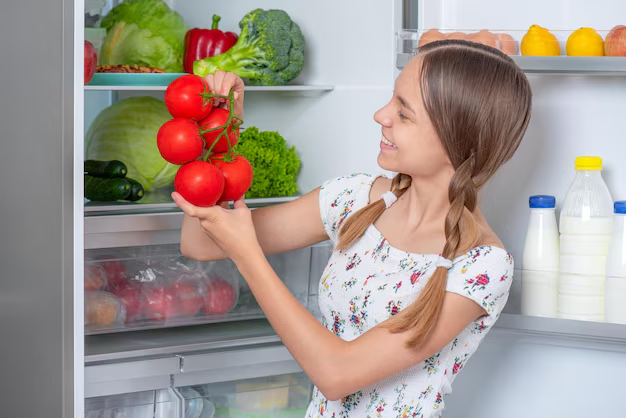The Ultimate Guide to Storing Cut Vegetables in the Refrigerator
Storing cut vegetables in the fridge may seem like a straightforward chore, but there's an art to keeping them fresh longer. Understanding the best methods ensures that your produce stays crisp and nutritious, reducing waste and saving money in the long run. With a little effort, you can enjoy fresh-tasting veggies any time you open the fridge!
🥕 Why Proper Storage Matters
Cut vegetables often experience rapid degradation compared to their whole counterparts. This means they can lose flavor, texture, and nutrients if not stored correctly. Moreover, improperly stored veggies can contribute to food waste and even impact your health if they go bad unnoticed. By mastering storage techniques, you're not just preserving produce; you're maximizing its potential.
Benefits of Proper Storage
- Extended Shelf Life: Well-stored veggies last longer, cutting down on frequent grocery runs and reducing wastage.
- Nutritive Value Maintained: Proper techniques help retain the important vitamins and minerals.
- Better Tasting Meals: Fresh vegetables enhance the flavor and appeal of your dishes.
🥒 Preparing Vegetables for Storage
Before diving into the specifics of refrigerator storage, it’s crucial to prepare your vegetables properly. Here’s a simple guide to get started:
Wash and Dry
Always wash your vegetables under cold water to remove any dirt, pesticides, or bacteria. This is especially important for produce that might be consumed raw, like carrots and bell peppers. After washing, ensure they are thoroughly dried. Excess moisture can promote the growth of mold and bacteria.
Cut with Care
When it comes to preserving cut vegetables, how you cut them can make a difference. Use a sharp knife to avoid bruising the veggies and cut them into larger pieces when possible to minimize exposure to air, which can speed up deterioration.
🧊 Optimal Refrigerator Storage Techniques
Once your vegetables are prepped, it’s time to store them correctly in the refrigerator. Here are some tips tailored to different types of produce:
Use Airtight Containers
For most cut vegetables, storing them in airtight containers or resealable bags is effective. These containers help reduce exposure to air, which can lead to oxidization. They also help retain the vegetable’s natural moisture.
Utilize the Crisper Drawer
Many refrigerators come equipped with a crisper drawer designed specifically for storing fruits and vegetables. These drawers help regulate humidity levels, with many models allowing you to adjust settings. Use your crisper drawer for:
- Leafy greens (e.g., lettuce, spinach) benefit from high humidity settings.
- Root vegetables (e.g., carrots, beets), which prefer low humidity.
Store with a Damp Paper Towel
For veggies like celery or asparagus, wrap them in a damp paper towel before placing in a container or bag. This helps maintain a suitable moisture level, preventing wilting.
Separate Ethylene Producers
Some fruits and vegetables produce ethylene gas, which can speed up the ripening process. Common ethylene producers include apples, bananas, and avocados. Keep these away from sensitive veggies like broccoli and leafy greens to prolong their freshness.
Temperature Control
Set your refrigerator between 34-40°F (1-4°C) for optimal produce storage. Any warmer can accelerate spoilage, while colder temperatures can risk freezing veggies, damaging their texture and taste.
🥦 Special Considerations for Specific Vegetables
Certain veggies have unique storage needs; here's a breakdown of a few:
Tomatoes
Although tomatoes aren't typically refrigerated, if cut, they should be used quickly. Store them in the fridge in a container, removing them some time before use to restore flavor and texture.
Avocados
Store cut avocados with the pit remaining, tightly wrapped in plastic to limit browning. A squeeze of lemon or lime juice can also help preserve color and flavor.
Onions and Garlic
Try to avoid refrigerating these if possible once cut. However, for short periods, they can be stored sealed in containers in the fridge to avoid odor spreading.
🍅 Visual Summary Section
Here's a quick summary of essential storage tips:
| Vegetable Type | Best Storage Method |
|---|---|
| Leafy Greens | Crisper drawer, high humidity, in containers with vents 🚪 |
| Cruciferous (like Broccoli) | Crisper drawer, low humidity, in perforated bags 🥦 |
| Roots (like Carrots) | Airtight containers or bags with a damp paper towel 🥕 |
| Sliced Tomatoes | Airtight container, consume soon 🍅 |
| Cut Avocados | Wrapped with plastic, pit in, lemon juice if possible 🥑 |
| Mixed Veggie Snacks | Pre-pack in airtight compartments for easy snacking 📦 |
🌿 Enhancing Vegetable Shelf Life with Smart Practices
Beyond basic storage, there are additional strategies to extend the freshness of cut vegetables.
Batch Prep and Rotate
Organize your fridge so that older veggies are at the front for easy access. Plan your meals around what needs to be used sooner rather than later.
Freeze Extras
If you find yourself with an abundance of certain veg, consider freezing. Flash-freezing cut vegetables on a baking sheet before transferring them to freezer bags can preserve taste and texture for later use.
Vacuum Seal
For those seeking even longer storage periods, vacuum sealing cut vegetables can dramatically extend their life by eliminating air exposure.
🍀 Conclusion: Eating Fresh, Living Smart
Proper storage of cut vegetables involves a mix of science and simple habits. By embracing these methods, you ensure your produce remains part of a fresh, convenient, and healthy lifestyle. Not only will your future self thank you as you reach for those still-crisp veggies days later, but you're also contributing positively to reducing food waste. Your refrigerator can become more than just an appliance – it’s a partner in keeping ingredients fresh and meals delicious!
Taking the time to store your vegetables correctly may require a bit of effort but offers extended freshness and flavor. Happy storing and enjoy the crisp crunch of fresh produce at your fingertips! 🥗
